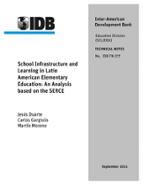School Infrastructure and Learning in Latin American Elementary Education: An Analysis Based on the SERCE
Date
Sep 2011
This study explores the state of infrastructure in the region's primary education schools, using the SERCE database, and analyzes the connection between school infrastructure conditions and language and mathematics tests results for third and sixth grade students. The results of the analysis indicate that school infrastructure and the access to basic services (electricity, water, sewerage and telephone) in the region's schools are highly deficient; there exists a large disparity between countries as well as between private urban, public urban and public rural schools; and there are large gaps between schools with children from high income families and schools with children from low income families. The analysis on the relationship between school infrastructure and academic results in the SERCE tests indicate that the highest factors most significantly associated with learning outcomes are: the presence of spaces that support teaching (libraries, science and computer labs); the connection to electric and telephone utilities; access to potable water, drainage and bathrooms. This indicates that countries in the region must strengthen investment geared towards improving school infrastructure in order to close the gaps that negatively affect rural areas, public sector schools, and schools with students from low income families. Likewise, public policies must prioritize infrastructure areas that have an impact on learning.



